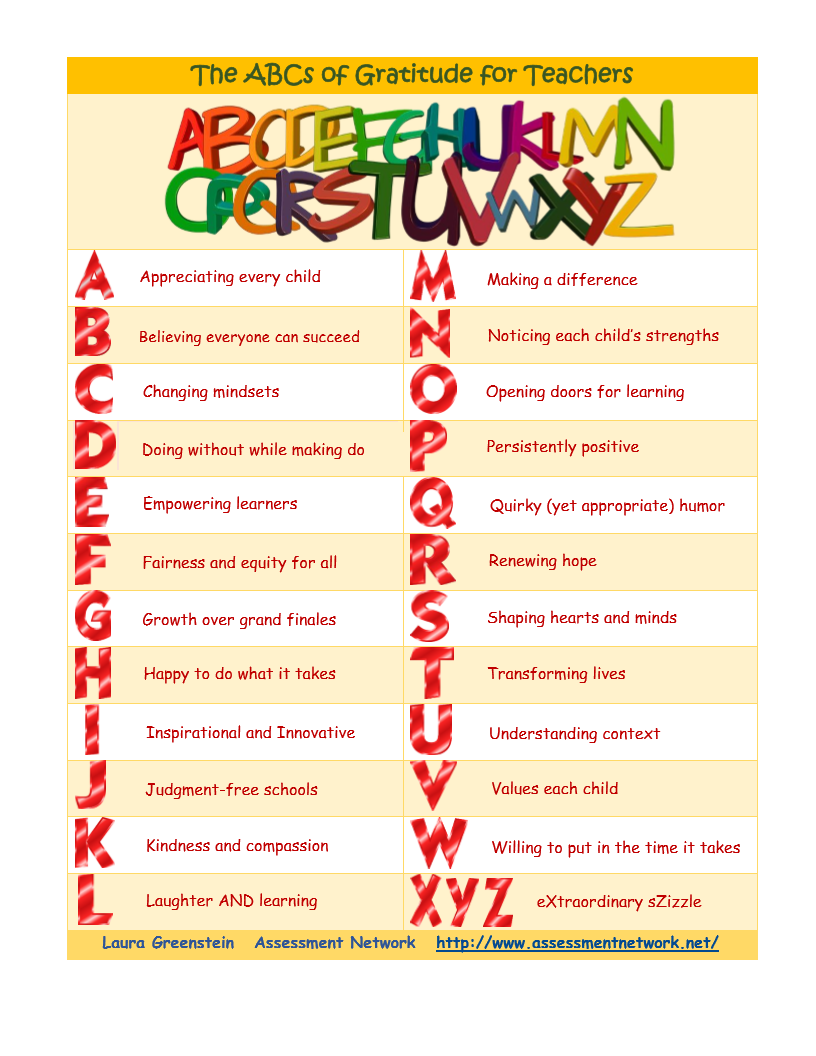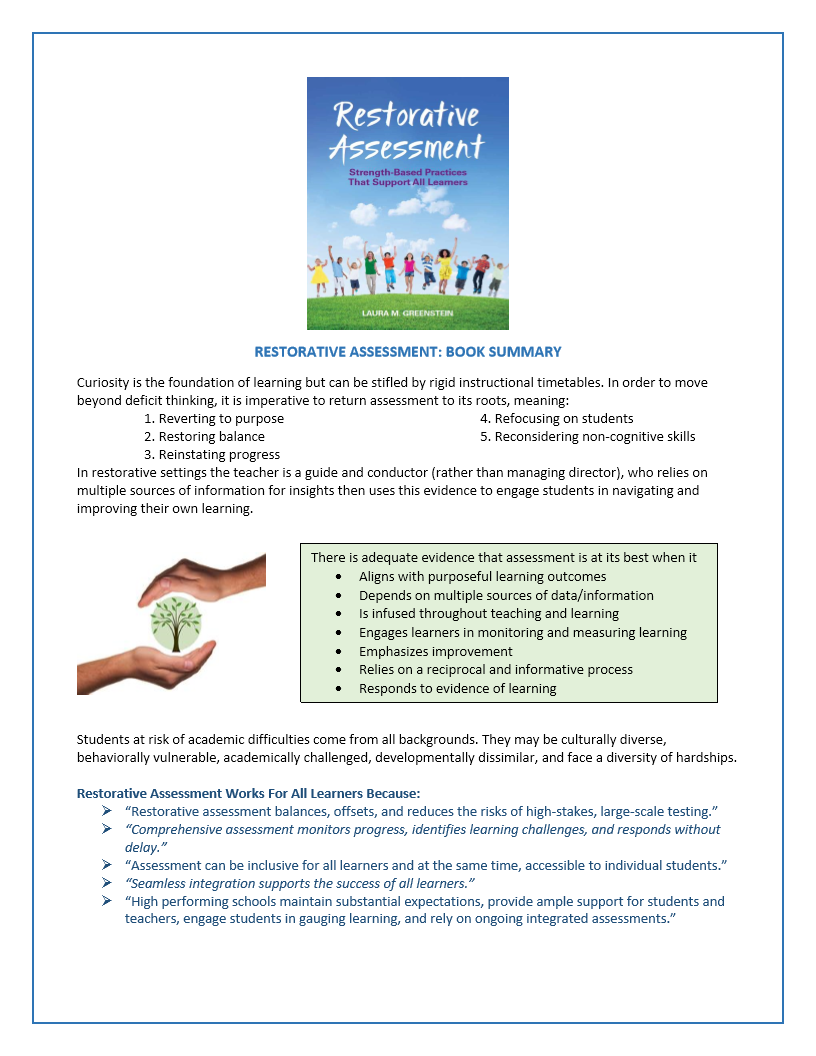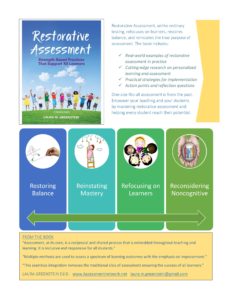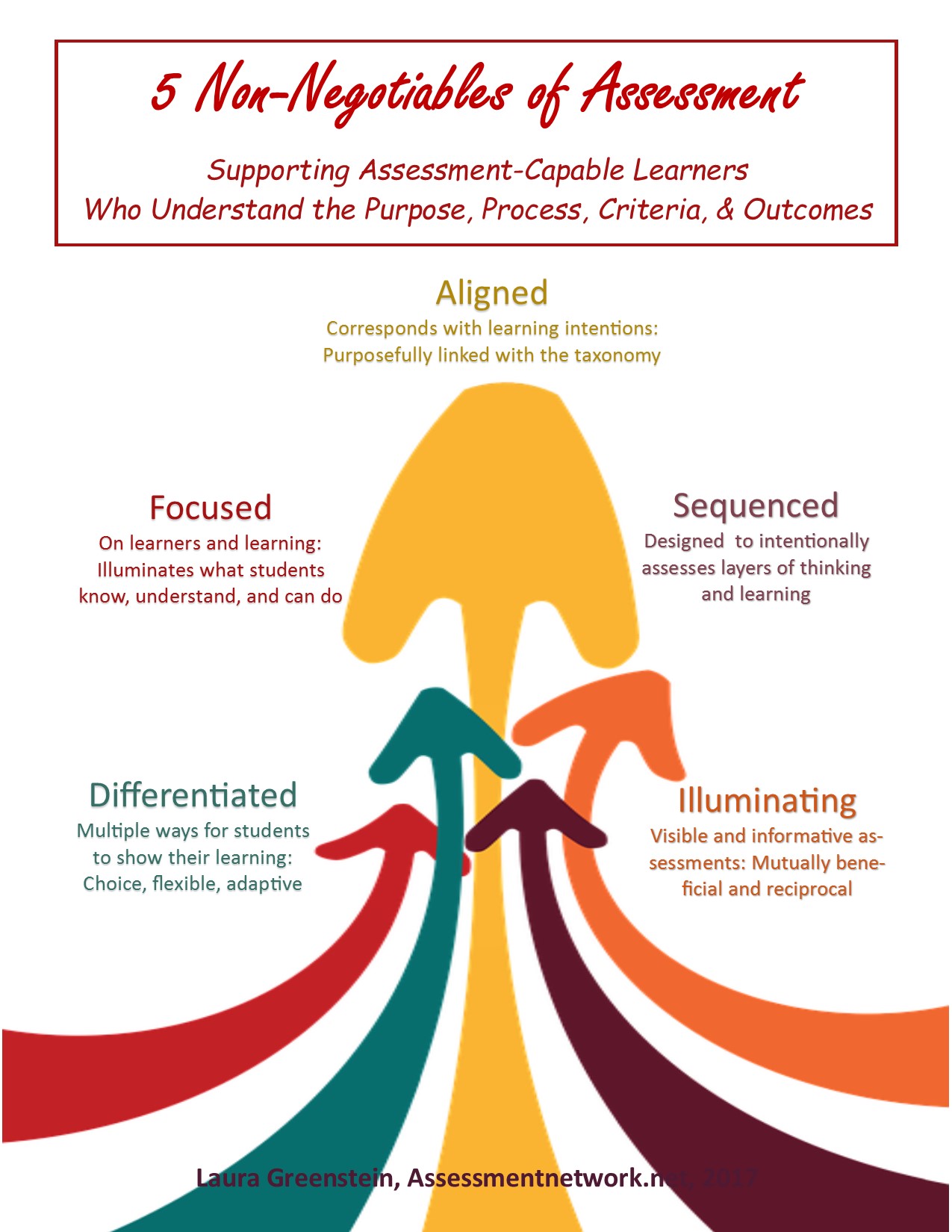Where Assessment Comes First
Blog, News, Tweets
- 20
Nov 17
0
- 06
Nov 17
0
RESTORATIVE ASSESSMENT: Chapter 1- Purpose
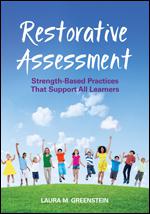
RESTORATIVE ASSESSMENT
Chapter 1: Reverting to Purpose
Assessment and testing have different meanings. A test is a tool for measuring. Number 1 could mean your golf handicap or your score out of a possible 10. Assessment extends beyond simply pointing out right and wrong answers. It is intended to illuminate learning, engage students, and guide improvement. Assessment is at its best when it:
- Synchronizes and sustains intentional and purposeful learning outcomes.
- Monitors progress throughout teaching and learning.
- Provides multiple pathways for students to demonstrate competency.
- Informs teachers and students of next steps towards closing gaps and improving understanding.
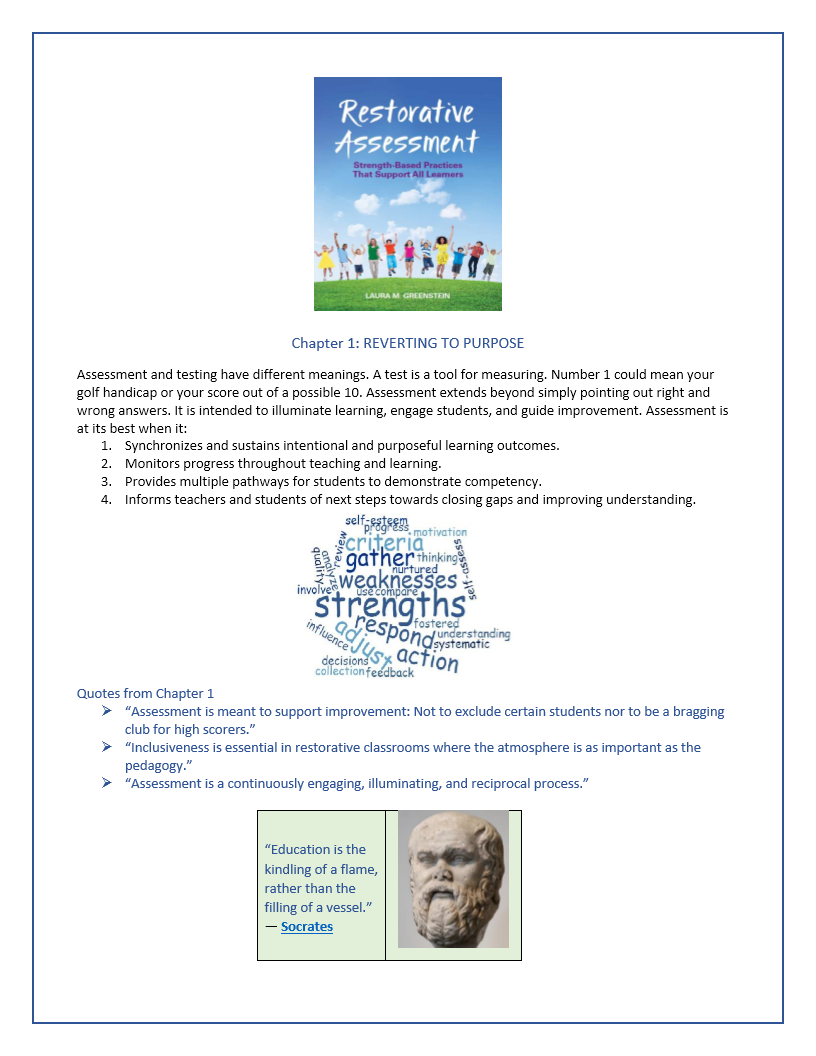
- 16
Oct 17
0
- 06
Oct 17
0
MORE ASSESSMENT FUN and GAMES
ASSESSMENT FUN and GAMES: Part 2: The first edition of this blog was popular at the start of the school year: Spot the Fake, Cross the Line, and Recipes. As the school year progresses here are three more assessments to engage students.
FUN* = Focused, Useful, eNgaging
WANTED POSTERS

Student-Designed Wanted Posters: Hunt for the antagonist using evidence and examples from the reading to explain his or her faults, describe character traits, and critique decisions and actions. This can be done individually or in small groups and is best when it includes a self-assessment checklist that aligns with learning intentions.
ALTERNATIVE: Students Create Help Wanted Posters: Individually or in small groups students create help wanted ads that describe the traits and attributes of one of the character’s in the narrative, historical event, etc.
Individually or in small groups student’s name the character that best matches the qualities in the ad. For example: Courageous, kind, and clever or Absent-minded, enthusiastic, and loyal. They defend their position using the character’s words, thoughts, and actions and can use additional facts or evidence from source materials. This works best when there are multiple characters in the story.
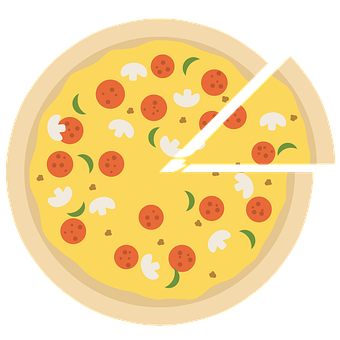
PIZZA INSIGHTS –
Student constructs a pizza image made up of 6 to 8 slices, each explaining their most notable or significant learnings. Alternatively, they identify one leading concept on each of the slices and then elaborate using toppings.
In science, Mr. Alamara labels the slices to align with a lesson on sources of energy (solar, coal, etc). Students annotate the slices with a description of the source, pros and cons, etc. In History, Ms. Marcus uses the pizza to summarize major time periods by identifying self-contained events such as hot peppers to identify specific wars and also to connect ongoing trends such as innovation using flowing cheese. Of course, graphic designs and real pizza can increase engagement.

TWO SIDES OF THE MIRROR–
For a lesson where there are opposing viewpoints: Individually students can summarize the diverse perspectives and fact-check questionable data, while building critical thinking skills. Applicable to a range of topics such as school uniforms or climate change. Consider using ProCon as a resource.
In addition, students can brainstorm and catalog ideas on how people develop to these diverse viewpoints.
Coming Next Q and A Mix-up, Team Trivia, ET News
- 05
Oct 17
0
- 18
Sep 17
0
Fundamentals of RESTORATIVE ASSESSMENT

Restorative justice dates back to the Babylonian Code of Hammurabi (@1700 B.C.) where it was believed that any crime harmed the whole community. In nursing, it refers to a healing process where the treatment is responsive to an identified need. Restorative assessment holds promise in education, especially for learners who may stumble through conventional measures. Assessment becomes restorative when it re-engages learners, restores confidence, and encourages progress, one resolute step at a time.
Restorative practice in school fosters a positive climate and empowers students as owners of learning. It is remarkably effective and especially essential for students who struggle to learn, are frustrated in school, and ultimately face failure.
Restorative assessments interrupt that sequence. It shifts the focus from assessments that indicate deficiencies to ones that illuminate strengths. With appropriate routines all types of learners, from the disengaged to the divergent can make progress towards mastery. Restorative assessment includes these essential elements.
- Reciprocal means that learning intentions are visible to both the student and the teacher. Expectations are clear and exemplars are available. Transparency, authenticity, accountability and dialogue offer a safety net. When anyone stumbles, be it the teacher, student, or learning partners, interventions and resolutions are prompt and focused.
- Responsive assessment relies on multiple types of evidence of student learning. It responds to strengths and challenges with just-right adjustments to practice, pacing, and depth. This formative approach, embedded throughout teaching and learning, incorporates feedback that is timely, specific, and actionable.
- Inclusive considers the needs of all learners and supports students as goal-setters and planners. It is fair and unbiased. Relevant learning intentions and reasonable challenge is supported by transparency, flexibility and enriching guidance.
- Restorative assessment starts with the learner and continually monitors their progress. It relies on multiple assessment methods throughout the taxonomies of learning. From knowing to producing, students rely on their strengths and overcome setbacks through reflection and self-assessment.
We live in a world of soundbites, but assessment cannot be restored simply with platitudes. Synthesizing what is proven about best practice improves learning outcomes for all students. This doesn’t require an extreme makeover, rather it relies on purposeful practice, complementary pathways, and balanced approaches and that engage the whole community and gets everyone on the ramp to success.
- 17
Aug 17
0
ASSESSMENT FUN AND GAMES
FUN: Focused, Useful, eNgaging
Is the FUN missing in your assessments? Tests may not provoke joy in your students, but these strategies can make assessment more user-friendly than traditional measures. These active assessments are informative, engaging, responsive, support student ownership, and of course, align with learning intentions.
SPOT THE FAKE
Choose the real news item from the list and defend your selection: This can be used as a pre-assessment, review of learning, or a concluding assessment. Alternatively students can correct fake news items. Even better, have students write fake news for others to evaluate and revise.
In Ms. Lo-Kuman’s health class, students generated these headlines for analysis.
1. Vitamin Cigarettes will add years to your life
2. Dihydrogen Monoxide can control your weight
3. Robassia is now selling specially grown dandelions to boost your immune system.
If you see something online and there’s a person’s picture with it, it must be true. Abraham Lincoln
 CROSS THE LINE
CROSS THE LINE
After learning (nutrition, insects, planets, weather, historic events, literature, etc.), students stand on a straight line. They move to one side or the other in response to questions such as: Are you more like calcium or iron, a bee or ladybug, Mercury or Neptune, a hurricane or landslide, Martin Luther King or Ruby Bridges, Sherlock or Watson? Using what they learned, they explain their position. Alternatively, they can collaborate with others on the same side and collectively describe their thinking.
Are you more like calcium or iron, a bee or ladybug, Mercury or Neptune, a hurricane or landslide, Martin Luther King or Ruby Bridges, Sherlock or Watson? Using what they learned, they explain their position. Alternatively, they can collaborate with others on the same side and collectively describe their thinking.
RECIPES
Create recipes for literary characters or historical figures- Each student writes one, other students guess, then explain and evaluate.
3 cups of friendship, zero common sense
1 teaspoon piquant sauce and a dash of self-determination
COMING NEXT: Wanted Poster, Pizza Wisdom, Two Sides of the Mirror, Q and A Summary, Team Trivia,
- 07
Aug 17
0
HOLISTIC* vs. ATOMISTIC* ASSESSMENT
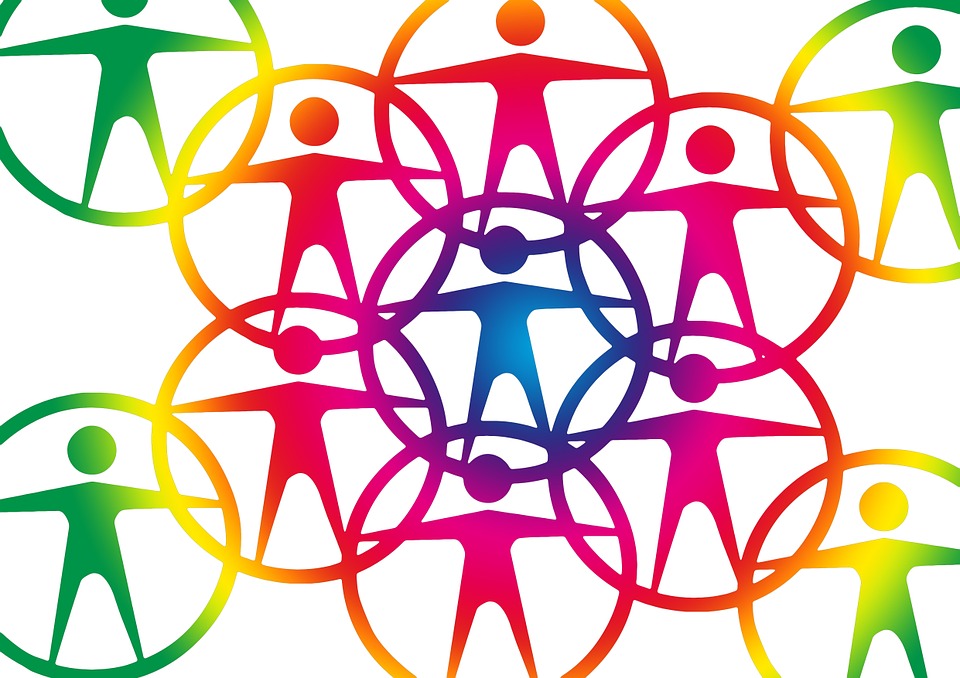 Holistic, similar to the word whole, means to develop comprehensive and coherent mental representations of learning. Rather than simply completing a selected-choice test, it means recognizing the schema of learning.
Holistic, similar to the word whole, means to develop comprehensive and coherent mental representations of learning. Rather than simply completing a selected-choice test, it means recognizing the schema of learning.
Holistic assessments are multidimensional in that they include varied facets of learning from recall of vocabulary to production of new ideas. Holistic assessments unify multiple learning outcomes into an integrated picture of student learning. What good does it do to know that the patient is bleeding without understanding anatomical pressure points? Why do we ask students to sequence the battles of war but not ask what would happen if the battles and their outcomes were altered?
To make assessment more holistic, consider ways you can turn traditional tests into multifaceted assessments: From knowing facts to understanding relationships and from labeling details to questioning evidence. Holistic strategies include well-thought-out projects, structured action research, and production of artifacts, each aligned with grade-level learning intentions. For example, a student may prepare a presentation of types of clouds, compare weather data at different elevations, or analyze research on climate change. When accompanied by self, peer, and teacher assessment, using rubrics along with more traditional measures, a full picture of the outcomes of learning becomes evident.
Benefits include:
Stronger links between learning intentions and learning actions
Clearer insights into student learning
Better guidance on modifications and interventions
Integration of assessment within teaching and learning
increased student ownership and engagement in learning and assessment
*Holistic and Wholistic both mean that the parts of something are interconnected and interdependent. They may be used interchangeably with medicine typically referring to treatment of the whole person and philosophy referring to a composite holistic belief system. One source adds to the confusion by saying that although the words have distinct meanings, they have similar definitions. Go Figure
**Atomic Assessment deconstructs standards into separate and distinct elements, then measures each of the elements. For example, in a unit on atoms student may show knowledge and understanding by defining electrons and explaining Dalton’s atomic theory, but go to deeper such as considering the pros and cons of harnessing nuclear energy.
- 01
Jun 17
0
TALKING WITH PARENTS ABOUT ASSESSMENT: 5 Things Parents Need to Know

1. Tests and Assessments Are Not the Same
A test examines a student’s knowledge, understanding, and skills to determine what level of learning has been reached. It generally results in a numerical or letter grade.
Assessment involves gathering, analyzing, and responding to a student’s strengths and misconceptions about their learning. It offers informative feedback to the learner and also guides the teacher’s practice: Similar to a BMI that provides a number but not a health analysis or fitness plan. There are times we need a test but more often success is built on assessment.
2. A Standardized Test Is Just a Snapshot
There’s nothing wrong with getting an annual family portrait to provide touchstones of change over time. But in the classroom, assessment that relies on a variety of strategies offers an ongoing kaleidoscope of a child’s skills and abilities. Rather than one test score, it is essential to routinely monitor progress and take steps towards continuous improvement.
3. Encourage and Acknowledge Progress
Children can become discouraged when they don’t get the score or rating they expected. So can adults, athletes, and accountants. With assessment it is okay to make mistakes as long as we learn from them. The goal of assessment is improvement and small steps are important in reaching the big picture goals. It’s not about the learning gaps; it’s how we cross over them.
4. Let’s Work Together: Stay Connected
All of our lives have ups and downs. If your child is going through a rough patch keep the teacher informed of their changing mindset, unusual setbacks, and setups that can support improvement. Follow your child’s progress on your school’s learning management system. Talk with them and their teacher about assignments and assessments, their progress, and what you can do at home to support learning.
5. Grades Don’t Mean Everything
Test scores and report cards do not represent the whole child. Emerging studies show that someone who is dependable or works conscientiously and diligently may be more successful in life than the one who studies 12 hours a day and gets high test scores. Maybe the child with a wonderful sense of humor, practical problem-solving skills, and a willingness to help others will go farthest.
“In school you are taught a lesson and then given a test. In life, you are given a test that teaches you a lesson” Tom Bodett

- 08
May 17
0
